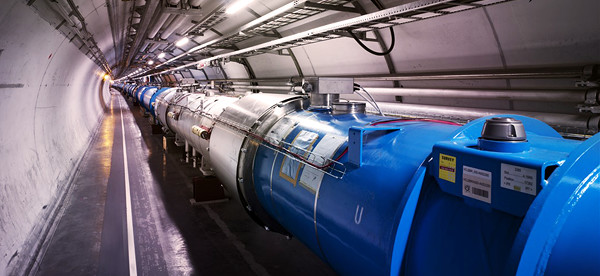Blue-skies research
Research with obvious, short-term applications such as that in energy and health is underpinned by a vibrant base in blue-skies research.
This kind of research is not necessarily driven by a specific goal, but is simply exploratory: scientists aim to understand the world around them, and tend to stumble across all manner of interesting and applicable surprises along the way.
It’s vitally important that we fund this so-called ‘basic’ research, but it’s much harder to draw catchy comparisons between the investment we make and the size of the objectives scientists are aiming for—often because, in the curiosity-driven world of blue-skies science, there aren’t any objectives other than understanding itself.

A high-profile contemporary example of blue-skies research is the Large Hadron Collider, or LHC, at CERN in Switzerland. It’s the largest scientific experiment ever built, an incredible engineering feat which accelerates protons to 99.999999% the speed of light—very nearly the fastest it’s possible to go—to probe the inner structure of matter and understand the fundamental workings of the Universe. Indeed, 2012 saw the discovery of a particle called the Higgs boson which explains why other particles like electrons have mass. This confirmed a theoretical prediction made in the 1960s, and won Peter Higgs and François Englert the 2013 Nobel prize.
This kind of fundamental research may sound intellectually decadent, but the LHC’s predecessor accelerators have been responsible for a variety of spin-out technologies, from health physics to microchip manufacture. In fact, if it weren’t for scientists at CERN, you might not be reading this at all—the lab provided the setting, in 1989, for the development of the World Wide Web. This is the kind of totally unforeseen spin-out we sometimes get from basic science: CERN’s high concentration of bright people and networked computers just happened to be in the right place at the right time. But when you write a grant application to investigate some obscure aspect of the nature of the Universe, it would be pretty bizarre to write ‘one in a million chance of revolutionising society’, even though that chance is implicit in many basic research projects.
Whilst we can’t be sure what application discoveries made at the LHC may have, the UK subscription to CERN sets us back just £1.50 per person per year; almost the same as the amount we spend on peanuts. In other words, discovering the Higgs boson literally cost peanuts. With the potential for hugely significant, totally unforeseen discoveries from a project at the cutting edge of our understanding of the Universe, this seems like a bargain.
The riposte from scientists working on renewable energy (which receives only a little more public funding than CERN), or stroke (at 37p per person per year), might be to observe that their fields too cost peanuts, but have very concrete applications. The answer here is surely not to cut funding the LHC—it’s to devote additional funding to those other areas. We have no idea what the cost would be of not learning what the LHC will go on to discover, so we’re each effectively buying a lottery ticket a year to fund CERN—except it’s a much more interesting gamble, with far better odds.
Unexpected discoveries
The LHC follows an illustrious heritage of projects with no specific social goal which have resulted in technologies which are all around us. Below are three examples that were extremely scientifically significant—all three resulted in a Nobel Prize for their discoverers—but have had an even more significant, unpredictable impact on our everyday lives.
Lasers
Developed in the early 1960s, lasers started out as a scientific curiosity, but their inventors could never have dreamed of their huge range of applications: from laser eye surgery in medicine to laser cutting in industry; from barcode scanners in supermarkets to DVD players and laser printers in homes and offices.

Antibiotics
The serendipitous discovery of penicillin, the world’s first antibiotic, is so well-known as to be almost cliché: Alexander Fleming, a Scottish biologist, noticed that bacteria weren’t growing in a small halo around some mould which had contaminated one of his samples. When the substance the fungus secreted was isolated, it turned out to be highly toxic to bacteria but largely harmless to humans. It wasn’t previously known that antibiotics even existed, but penicillin and subsequent antimicrobial drugs have saved millions of lives.
Giant magnetoresistance
In 1988, separate research groups in Germany and France observed a strange effect when dealing with very thin layers of magnetic materials: depending on their relative direction of magnetic alignment, it became significantly easier or more difficult for an electrical current to pass through them. This was an exciting piece of new physics, and earned its co-discoverers the 2007 Nobel Prize in Physics. However, technology moves faster than the Nobel Prize committee; it was a decade earlier that materials exhibiting this effect had found their way into hard disk drives…and they’re still there; if you’re reading this on a computer, it’s probably making use of this effect right now.